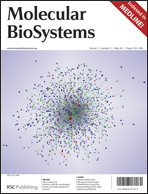An understanding of interaction of nanomaterials with living systems is fundamental to address nanosafety issues, which, in turn will dictate the future prospects of nanomedicine. Herein, we examine the molecular effects of uptake of Magnetite (Fe3O4) Nanocrystals (MNC) using a transcriptomics approach. The uptake of MNC was studied by electron microscopy. This was followed by transcriptional profiling using whole genome microarrays, functional analysis of microarray data, real time PCR and biochemical assay for CASP9. Transcriptional profiling revealed 69 genes to be differentially expressed upon MNC treatment. Many of these genes are associated with TGF-beta signaling and include ID1, ID2, ID3, CASP9, SMAD6 and SMAD7, which are important negative regulators of signaling pathways involved in development and tumorigenesis. Moreover, upon treatment with MNC, expression of CASP9 was also found to decrease in a dose dependent manner. This approach could help us to identify specific effects of MNC upon cells and give us simultaneous clues about their biocompatibility and therapeutic potential. The MNC can specifically interfere with TGF-beta signaling by inhibiting the expression of ID and SMAD genes. As TGF-beta signaling invokes different responses in undifferentiated cells and adult tissues in a cell-type specific manner, our findings have far reaching implications in cellular development, differentiation and cancer.

You have access to this article
 Please wait while we load your content...
Something went wrong. Try again?
Please wait while we load your content...
Something went wrong. Try again?


 Please wait while we load your content...
Please wait while we load your content...